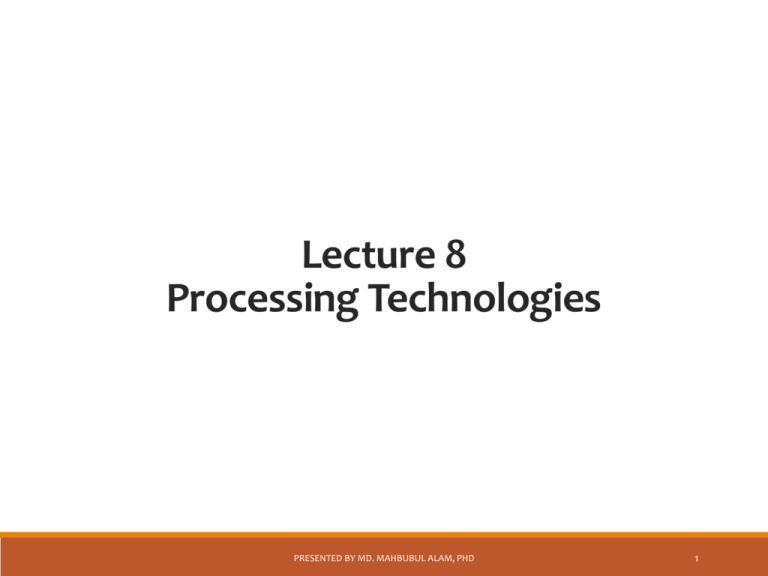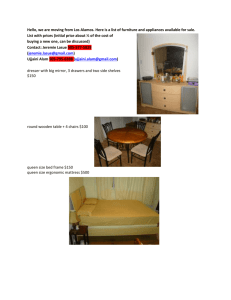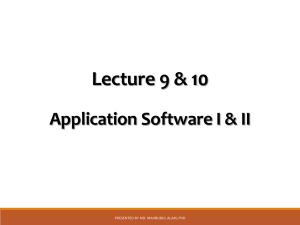Introducing Computer Systems
advertisement

Lecture 8 Processing Technologies PRESENTED BY MD. MAHBUBUL ALAM, PHD 1 Data and Information Data: ◦ Data is a set of values of qualitative or quantitative variables. ◦ Can be measured, collected and reported, and analyzed. ◦ Data as an abstract concept can be viewed as the lowest level of abstraction, from which information and then knowledge are derived. ◦ Raw data, i.e., unprocessed data, refers to a collection of numbers and characters generated within the context of an investigation by observation and recording. Information: ◦ Simply put, information is processed data which is meaningful and can be used to make any sort of informed decision. PRESENTED BY MD. MAHBUBUL ALAM, PHD 2 Data vs. Information Data Information Raw facts Useful and relevant Unorganized Organized Unprocessed Processed Chaotic and unsorted Ordered and sorted Input to a process Output to a process PRESENTED BY MD. MAHBUBUL ALAM, PHD 3 Text Codes Text codes enable any programmer or program to use the same combinations of numbers to represent the same individual piece of data. The four most popular text code systems are: ◦ ◦ ◦ ◦ EBCDIC ASCII Extended ASCII Unicode PRESENTED BY MD. MAHBUBUL ALAM, PHD 4 Text Codes (cont’d) EBCDIC – stands for Extended Binary Coded Decimal Interchange Code. EBCDIC is an 8 bit code that defines 256 symbols. It is still used in IBM mainframes and midrange systems, but rarely used in personal computers. ASCII – stands for American Standard Code for Information Interchange. This is the mostly used code in all types of computers. ASCII is an 8 bit code that specifies characters for values from 0 to 127. Extended ASCII – is an 8 bit code that specifies the characters values from 128 to 256. Unicode – the Unicode Worldwide Character Standard provides up to 4 bytes (32 bits) to represent each letter, number or symbol. With 4 bytes, Unicode can create more than 4 billion different character or symbols. PRESENTED BY MD. MAHBUBUL ALAM, PHD 5 How Computers Process Data Two components handle processing in a computer: The central processing unit (CPU), and The memory Both these components are located on the computer’s motherboard PRESENTED BY MD. MAHBUBUL ALAM, PHD 6 The CPU The CPU is the brain of the computer, the place where data is manipulated. In large computer systems, such as supercomputers and mainframes, processing tasks are handled by multiple processing chips. Every CPU has at least two parts: The control unit o The control unit is the logical hub of the computer, which carries out all the instruction traffics. The arithmetic logic unit o Involves in comparing numbers or carrying out mathematical operation. PRESENTED BY MD. MAHBUBUL ALAM, PHD 7 Memory The CPU contains the basic instructions needed to operated the computer, but it can not store entire program or large sets of data permanently. Thus there is requirement of memory. Memory consists of chips either on the motherboard or on a small circuit board attached to the motherboard. There are two types of built-in memory: permanent and non-permanent Some memory chips retains the data they hold even when the computer is turned off. This type of permanent memory is called nonvolatile. Other chips looses the content when the computer is turned off and are called volatile. PRESENTED BY MD. MAHBUBUL ALAM, PHD 8 Nonvolatile Memory Nonvolatile chips hold data even when the computer is unplugged. During normal use, the data in these chips is only read and used – not changed – so the memory is called read-only-memory (ROM). Example: Basic Input Output System (BIOS) which deals with boot process and device functionality. PRESENTED BY MD. MAHBUBUL ALAM, PHD 9 Flash Memory Flash memory is one type of non-volatile memory. It is mostly used in portable digital devices as a mean of storage. Digital cameras, portable MP3 players, USB and so forth use flash memory PRESENTED BY MD. MAHBUBUL ALAM, PHD 10 Volatile Memory Volatile memory requires power to store data. The volatile memory in a computer is called random access memory (RAM). RAM’s job is to hold programs and data while they are in use. RAM is designed to be instantly accessible by the CPU or programs. PRESENTED BY MD. MAHBUBUL ALAM, PHD 11 Machine Cycle • Each time the CPU executes an instruction, it takes a series of steps. The completed series of steps is called a machine cycle. • A machine cycle can be broken down into two smaller cycles: • The instruction cycle • The execution cycle • Although the process is complex, the computer can accomplish it at an incredible speed, translating millions of instructions every second. In fact, CPU performance is often measured in millions of instructions per second (MIPS) or billions of instructions per second (BIPS) PRESENTED BY MD. MAHBUBUL ALAM, PHD 12 Machine Cycle (cont’d) • At the instruction cycle, CPU takes two steps: Fetching: Before the CPU can execute an instruction, the control unit must retrieve (or fetch) a command or data from the computer’s memory. Decoding: Before a command can be executed, the control unit must break down (or decode) the command into instructions that correspond to those CPU’s instruction set. • At the execution cycle CPU takes two steps: Executing: When the command is executed, the CPU carries out the instructions in order by converting them into microcode Storing: The CPU may be required to store the results of an instruction in memory (but this condition is not always required) PRESENTED BY MD. MAHBUBUL ALAM, PHD 13 Factors Affecting Processing Speed • A CPU’s design determines its basic speed, but other factors can make chips already designed for speed work even faster. Several factors are-- Registers Memory and Computing Power The Computer’s Internal Clock The Bus Cache Memory PRESENTED BY MD. MAHBUBUL ALAM, PHD 14 Registers The registers in the first PCs could hold two bytes – 16 bits Most CPUs today have 32 bit registers or even 64 bit registers Registers are the transistors used in the processor which determines the processing speed PRESENTED BY MD. MAHBUBUL ALAM, PHD 15 Memory and Computing Power The memory size of RAM in a computer can have a profound effect on the computer's power. More RAM means the computer can use bigger, more powerful programs, and those programs can access bigger data files. PRESENTED BY MD. MAHBUBUL ALAM, PHD 16 The Computer’s Internal Clock Every microcomputer has a system clock, but the clock’s primary purpose is not to keep the time of the day. Hertz (Hz) is a measure of cycles per second. Megahertz (MHz) means millions of cycles per second and Gigahertz (GHz) means billions of cycles per second. Internal clock is monitoring this cycle time of processing. PRESENTED BY MD. MAHBUBUL ALAM, PHD 17 The Bus Bus is a path between the components of a computer. There are two main buses in a computer: Internal (or system) bus, and External (or expansion) bus The system bus has two parts: Data bus, and Address bus Like processor the bus speed is measured in megahertz (MHz), the more bus speed the more processing speed. PRESENTED BY MD. MAHBUBUL ALAM, PHD 18 Cache Memory Moving data between RAM and the CPU’s registers is one of the most time consuming operations a must perform, because RAM is much slower than CPU. A partial solution to this problem is to include a Cache memory in the CPU, which stores most frequent instruction. Memory size of Cache increases the processing performance L1 Cache is the built-in cache inside the processor and L2 Cache is the additional or extendable component. PRESENTED BY MD. MAHBUBUL ALAM, PHD 19 Processor A processor is the logic circuitry that responds to and processes the basic instructions that drive a computer. The term processor has generally replaced the term central processing unit (CPU). The processor in a personal computer or embedded in small devices is often called a microprocessor. Commonly used processors are Intel Advanced Micro Devices (AMD) Freescale IBM PRESENTED BY MD. MAHBUBUL ALAM, PHD 20 Microcomputer Processors Intel ◦ Intel is the leading manufacturer of processors where Intel 4004 was worlds first microprocessor. IBM PC powered by Intel 8086. ◦ Current processors: Centrino, Itanium, Pentium IV, Xeon, Core Advanced Micro Devices (AMD) ◦ Main competitor of Intel, competes with budget products. ◦ Current processors: Sempron, Athlon FX 64, Athlon XP Freescale ◦ A subsidiary of Motorola ◦ Co-developed the Apple G4 PowerPC ◦ Currently focuses on the Linux market IBM ◦ Historically manufactured mainframes ◦ Partnered with Apple to develop G5 ◦ First consumer 64 bit chip PRESENTED BY MD. MAHBUBUL ALAM, PHD 21 Microcomputer Processors (cont’d) RISC Processors (Reduction Instruction Set Computing) o Processors in IBM-compatible PCs are ‘complex instruction set computing (CISC)’ processor. The instruction sets for these CPUs are large, typically containing 200 to 300 instructions. o In RISC processors, the instruction set for the CPU is small and simple. Therefore, each instruction is executed in much less time and allowed the processor to complete more instructions during a given period of time. o RISC processors are the faster and less expensive processor. Parallel processing o Use more than one processor called Multiprocessing (MP) system. o Handle a much greater flow of data, complete more tasks in a shorter time. o Deals with the demands of many input and output devices. PRESENTED BY MD. MAHBUBUL ALAM, PHD 22 Comparing Processors Speed of processor Size of cache Number of registers Bit size Speed of Front side bus PRESENTED BY MD. MAHBUBUL ALAM, PHD 23 CPUs’ Performance Specification Specification AMD Athlon 64 FX Intel Pentium IV PowerMac G5 Number of registers 16 16 80 Word size 64 bits 32 bits 64 bits System bus speed 1.6 GHz 800 MHz 1 GHz L1 Cache 128 KB na na L2 Cache 1024 KB 512 KB 512 KB PRESENTED BY MD. MAHBUBUL ALAM, PHD 24 Standard Computer Ports All modern computers come with the same basic set of ports. These allow us to connect common devices to the computer. PRESENTED BY MD. MAHBUBUL ALAM, PHD 25 Standard Computer Ports Keyboard and mouse ports: Accepts the keyboard and mouse plugs. USB ports: These accepts any USB supported device Serial port: Connects external modems Parallel port: Connects older printers Audio port: Typically three audio ports. Green one is for speaker or headphone, pink one is for microphone and yellow one is for home stereo system Network port: Connects the internet cable Modem port: Connects computer with land phone line Monitor port: Connects the computer monitor Other ports: SCSI (Small Computer System Interfaces, IEEE 1394 (FireWire), MIDI (Musical Instrument Digital Interface) PRESENTED BY MD. MAHBUBUL ALAM, PHD 26 End of Chapter PRESENTED BY MD. MAHBUBUL ALAM, PHD 27



